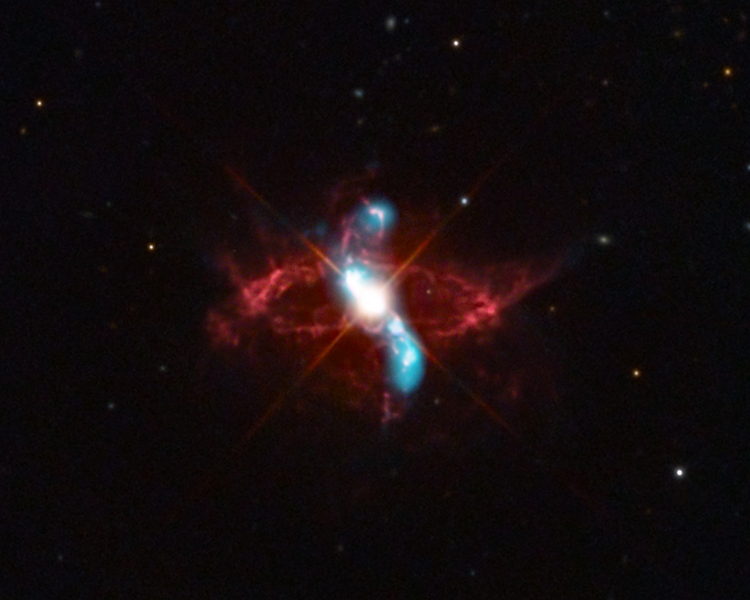
 Credit: X-ray: NASA/CXC/SAO/R. Montez et al.; Optical: Adam Block/Mt. Lemmon SkyCenter/U. Arizona
Credit: X-ray: NASA/CXC/SAO/R. Montez et al.; Optical: Adam Block/Mt. Lemmon SkyCenter/U. Arizona
Gains and Losses
Companions generally affect behavior in people, and stars are no different. Interactions between stars that are gravitationally bound to each other can significantly change the ways these stars evolve. Stellar evolution is driven primarily by stellar mass, with more massive stars changing first as they consume their nuclear fuel more quickly. So in a stellar binary, the more massive star will evolve before the less massive one, even consuming all its fuel and becoming some kind of compact stellar cinder while their companion shines on. The system R Aquarii is one well-studied example of this complicated evolutionary process. R Aquarii is composed of a swollen Red Giant star and a white dwarf star, the compact leftover of a normal star which has entirely consumed its thermonuclear fuel. A white dwarf is extremely dense (a sugar-cube sized piece of white dwarf material would weigh more than a car) and thus has a very strong gravitational field. As the stars orbit around each other, material from the Red Giant can fall onto the surface of the white dwarf, a potentially dangerous situation: if the amount of matter accreted by the white dwarf grows too large, the white dwarf's mass can exceed the Chandrasekhar limit, the maximum amount of matter a white dwarf can sustain. It that limit is exceeded, the white dwarf will collapse and explode, destroying the binary. But as hydrogen-rich material from the Red Giant falls onto the white dwarf, it is compressed by the extremely strong gravity of the white dwarf, and heated up to such a degree that the hydrogen-rich material can explosively fuse into helium, producing a thermonuclear nova explosion that drives material from the surface of the white dwarf into space. The image above shows a composite optical (in red) and X-ray (in cyan) image of R Aqr and the region around the star. The space around R Aqr is structured by the material blown off the white dwarf, some in the form of a ring of material seen optically, while some of the material forms an X-ray emitting jet orthogonal to the ring. Observations with the Chandra X-ray Observatory over nearly 20 year have shown how the X-ray emitting jet itself changes as the material in the jet expands into space.
Published: June 12, 2017
<
HEA Dictionary ● Archive
● Search HEAPOW
● Other Languages
● HEAPOW on Facebook
● Download all Images
● Education ● HEAD
>

Each week the HEASARC
brings you new, exciting and beautiful images from X-ray and Gamma ray
astronomy. Check back each week and be sure to check out the HEAPOW archive!
Last modified Tuesday, 27-Feb-2024 10:10:15 EST


